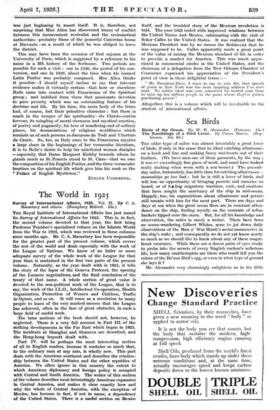The World in 1925
Survey of International Affairs 1925. Vol. U. By C. A. Macartney and others. (Humphrey Milford. 25s.)
THE Royal Institute of International Affairs has just issued its Survey of International Affairs for 1925. This is, in fact, the second volume devoted to that year, the first being Professor Toynbee's specialized volume on the Islamic World from the War to 1925, which was reviewed in these columns some months ago. Mr. C. A. Macartney has been responsible for the greater part of the present volume, which covers the rest of the world and deals especially with the work of the League of Nations. We know of no fuller or more adequate survey of the whole work of the League for that year than is contained in the first two parts of the present volume. Naturally, as the year dealt with is 1925, it tells the story of the lapse of the Geneva Protocol, the opening of the Locarno negotiations, and the final conclusion of the treaty of that name. A whole section of great value is devoted to the non-political work of the League, that is to say, the work of the I.L.O., Intellectual Co-operation, Health Organization, Protection of Women and Children, Traffic in Opium, and so on. It will come as a revelation to many people to learn of the very marked success that the League has achieved, often in the face of great obstacles, in such a large field of useful work.
The later sections of the book should not, however, be neglected. There is a very full account in Part III. o f the strilcing developments in the Far East which began in 1925. The incidents at Shanghai and Shameen are described, and the Hong-kong boycott dealt with.
Part IV. will be perhaps the most interesting section of all to English readers, because it contains so much that, to the ordinary man at any rate, is wholly new. This part deals with the American continent and describes the relation- ship between the United States and the other republics of America. We often ignore in this country the extent to which American diplomacy and foreign policy is occupied with Central and South America. The writer of this section of the volume describes most interestingly American expansion in Central America, and makes it clear exactly how and why the whole of Central America, with the exception of Mexico, has become in fact, if not in name, a dependency of the United States. There is a useful section on Mexico itself, and the troubled story of the Mexican revolution is told. The year 1925 ended with improved relations between the United States and Mexico, culminating with the visit of Seiior Galles to the United States. It was realized that the Mexican President was by no means the Bolshevist that he was supposed to be. Calles apparently made a great point of the value of raising the Mexican standard of life in order to provide a market for America. This was much appre- ciated in commercial circles in the United States, and the chairman of a delegation from the New Orleans Chamber of Commerce expressed his appreciation of the President's point of view in these delightful terms :—
" Mr. President-Elect, I want to say to you, Sir, that speech of yours in New York was the most inspiring address I've ever read. No nobler ideal was ever conceived by mortal man than to raise up ten million people to the point where they've gotten purchasing power."
Altogether, this is a volume which will be invaluable to the student of international affairs.






































 Previous page
Previous page